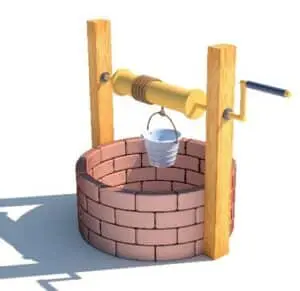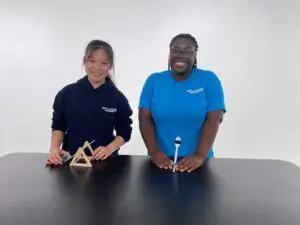Per person or team:
- stuff to make the posts or struts for the winch: cardboard tubes or boxes; packing blocks that can be cut, like molded pulp or Styrofoam
- cutting board or rectangle of cardboard for the base if you can’t tape directly to a hard surface
- empty ribbon or thread spool
- straws, pencils, pens, or skewers
- string or thin ribbon
- tape
- scissors
- paper cup
- light stuff to put in the cup, such as candies, paper clips, beads, cotton balls
- ledge, such as the edge of a desk, table, or counter
- ruler
- sketching materials
INTRODUCTION
People have been digging wells to access clean water since prehistoric times, and they’ve been relying on the simple machine known as a winch—along with a rope and bucket—to get the water out. Hand winches are tools that make it easier to lift or pull loads. They have a rotating drum with a rope or chain that winds around it. The drum has a crank to make it turn. When the drum rolls one way, the rope unwinds; when rolled the opposite way, the rope winds back around the drum. The drum is held up on either side with posts or struts so it can support a lot of weight.
Student Challenge:
Design a well winch that can lower an empty bucket down into a “well” and lift the full bucket up again.
Success Criteria
- The winch lowers the bucket at least one foot.
- The winch hauls the filled bucket up
- The bucket doesn’t spill out when lifted.
- The winch operates steadily, without the bucket slipping at any point.
Constraints
- Use only the materials provided, but you don’t have to use all of them.
- The drum of the winch rotates to release the string or wind it back up.
- The winch is operated by a handle, called a crank.
Instructions
DEFINE THE PROBLEM
Ask students what they know about wells. Have they seen pictures of wells in storybooks? Together, ask them to draw a well from memory or consult a picture.

Share that a winch is a mechanism that lowers and raises the well’s bucket. Point out the posts, crank, drum, and rope in the picture, and then explore with them how a winch works. Ask:
- How will the drum and crank need to work together? How can you keep the crank from slipping?
- Why are the supports important? Which force(s) are they resisting?
- How do pulleys work? How can you use pulleys in your winch to make it lift the bucket better?
Share the challenge, success criteria, and constraints with students. Ensure that each team has a suitable ledge from which to lower and raise their buckets and let them know whether they can tape directly to a flat surface or if you want them to build their winches on bases.
BRAINSTORM SOLUTIONS
Ask teams to explore the materials to start generating ideas for designs.
Encourage them to sketch some ideas for how to build their own well winches, keeping their materials and constraints in mind.
BUILD AND TEST
Tell teams to build their winches. How should the bucket attach to the string so that it so that the contents don’t spill out of the bucket? Will it matter which way the drum rotates to wind the string up or let it down?
For the test, one team member should be ready to measure how far down the bucket can drop, remembering that it needs to drop by at least one foot. Another team member may need to hold the base of the winch steady, if it has been built on a base.
Once the bucket is lowered, fill it to the brim. Then slowly raise the bucket to the lip of the ledge, or as high as it can go.
EVALUATE AND REDESIGN
How well did the winch work? Ask each team to describe their results, including any problems they encountered. For example, if the drum didn’t turn, what did the team change to make it move? Engineers rarely get it right on the first try and they learn a lot from their mistakes. Each team should listen to the others so that they can get ideas for improving their own winches.
Make improvements and try their winches out again.
Or, try a different version. Can teams make a winch that lowers a bucket into a bowl of water and brings the full bucket up again, the way a real well winch does? What if they made a bigger winch that hangs from part of the playground? How heavy a load could it hold?
Engineering & Science Connections
Simple machines are tools or devices that help us accomplish tasks. They make work easier by providing a mechanical advantage, which is how much force the simple machine adds to our efforts. The handle that rotates the drum of the winch is the part that provides a mechanical advantage. It makes it possible for someone to pull up a heavy bucket of water that they’d never have the strength to do otherwise.
When you pry open a can or move up and down on a seesaw, you are using the simple machine called a lever. In modern winches, there are two kinds of levers. The handle of the winch is one lever. The other is the gears inside the drum; these produce torque, the twisting force of rotating around an axis, which is the drum of the winch. The faster the winch works, the more rope it pulls every time the handle rotates, and the less powerful it is. The more slowly the winch turns, the more power and torque it produces.
The kind of winch used to hoist water from wells was known as a windlass. Nowadays, a windlass is a big winch that raises and lowers anchors from boats. Boats also use windlasses for hauling mooring lines. A chain or cable winds around a barrel, and a crank attached to the barrel rotates it. For big ships, engineers have created a windlass that distributes the very heavy load of the anchor among many cables instead of just one. A system of pulleys—another example of winches—works together to coordinate the cables and work the anchor.






2 Comments
This looks wonderful!
Great!